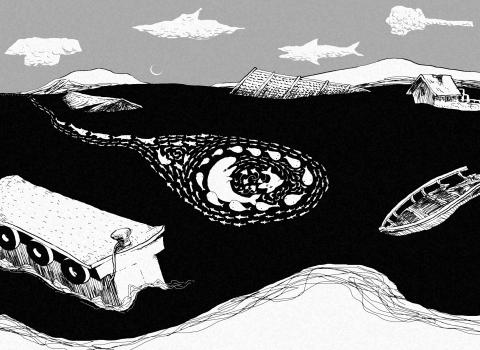When a floating dock the size of a boxcar washed up on a sandy beach in Oregon, beachcombers got excited because it was the largest piece of debris from last year’s tsunami in Japan to show up on the US west coast.
However, scientists worried it represented a whole new way for invasive species of seaweeds, crabs and other marine organisms to break the Earth’s natural barriers and further muck up the west coast’s marine environments, and more invasive species could be hitching rides on tsunami debris expected to arrive in the weeks and months to come.
“We know extinctions occur with invasions,” said John Chapman, assistant professor of fisheries and invasive species specialist at Oregon State University’s Hatfield Marine Science Center. “This is like arrows shot into the dark. Some of them could hit a mark.”

Though the global economy has accelerated the process in recent decades by the sheer volume of ships, mostly from Asia, entering west coast ports, the marine invasion has been in full swing since 1869, when the transcontinental railroad brought the first shipment of east coast oysters packed in seaweed and mud to San Francisco, said Andrew Cohen, director of the Center for Research on Aquatic Bioinvasions in Richmond, California. For nearly a century before then, ships sailing up the coast carried barnacles and seaweeds.
Now, hot spots like San Francisco Bay amount to a “global zoo” of invasive species and perhaps 500 plants and animals from foreign shores have established in US marine waters, said James Carlton, professor of marine sciences at Williams College. They come mostly from ship hulls and the water ships take on as ballast, but also get dumped into bays from home aquariums.
The costs quickly mount into the untold billions of US dollars. Mitten crabs from China eat baby Dungeness crabs that are one of the region’s top commercial fisheries. Spartina, a ropey seaweed from Europe, chokes commercial oyster beds. Shellfish plug the cooling water intakes of power plants. Kelp and tiny shrimp-like creatures change the food web that fish, marine mammals and even humans depend on.
A 2004 study in the scientific journal Ecological Economic estimated 400 threatened and endangered species in the US are facing extinction because of pressures from invasive species.
It is too early for scientists to know how much Japanese tsunami debris may add to the invasive species already here.
“It may only introduce one thing,” Cohen said. “But if that thing turns out to be a big problem, we would rather it not happen. There could be an economic impact, an ecological impact or even a human health impact.”
The dock, torn loose from a fishing port on the northern tip of Japan, was covered with 1.5 tonnes of seaweed, mussels, barnacles and even a few starfish. Volunteers scraped it all off, buried it above the high water line, and sterilized the top and sides of the dock with torches.
However, there was no telling whether they might already have released spores or larvae that could establish a foothold in a bay or estuary as it floated along the coast, Carlton said.
“That’s the ‘Johnny Clamseed’ approach,” he said, referring to Johnny Appleseed, the pioneer US apple tree planter of the early 19th century. “While that is theoretical, we don’t actually know if that kind of thing happens.”
One thing they know is that the bigger the debris, the more likely it has something on it.
Chapman estimated there were hundreds of millions of individual living organisms on the dock when it washed up on Agate Beach outside Newport, Oregon.
However, even a small plastic float that washed up on a beach in Alaska carried a live oyster, said Mandy Lindeberg, research scientist at the National Oceanic and Atmospheric Administration (NOAA) Fisheries Auke Bay Laboratories in Juneau, Alaska.
The smaller bits of plastic expected to make up most of the tsunami debris will not have anything except species they picked up at sea, Carlton said.
On the dock, about half the plant species already exist on the west coast, said Gayle Hansen, a research marine taxonomist at Oregon State University, who has spent hours with her eye scrunched up against a microscope examining samples from the dock.
Among the exotic seaweeds was one known as wakame, which has become a nuisance around the world, but is not yet found in Oregon, she said.
Whether hitchhiking species will survive here depends on randomness, she said. Seaweeds probably would not have survived to reproduce in the crashing surf at Agate Beach. It is the wrong kind of environment. However, if they had floated into Yaquina Bay, very similar to their home waters in Japan, they could grow and reproduce.
“The only defense for invasive species is early detection. Just like cancer,” Lindeberg said.
While monitoring is relatively cheap, say US$30,000 to watch nearby waters for species from the dock, trying to stop an established invasion is expensive. California spent US$7 million trying to eradicate a seaweed, she said.
She said she hoped there would be funding for monitoring tsunami invasive species.
James Morris, a marine ecologist and invasive species specialist at the NOAA National Centers for Coastal Ocean Science, in Beaufort, North Carolina, said the idea a natural disaster like the tsunami could introduce a new avenue for invasive species is intriguing.
“It goes to show you that when it comes to invasive species, there are some things you can work to regulate and control,” he said. “And there are issues like this that come up that open up a whole different realm of possibilities.”
You wish every Taiwanese spoke English like I do. I was not born an anglophone, yet I am paid to write and speak in English. It is my working language and my primary idiom in private. I am more than bilingual: I think in English; it is my language now. Can you guess how many native English speakers I had as teachers in my entire life? Zero. I only lived in an English-speaking country, Australia, in my 30s, and it was because I was already fluent that I was able to live and pursue a career. English became my main language during adulthood

Somehow, US intelligence identified “the Houthis’ top missile guy” and pinpointed his exact location. At 1348 hours (Washington time), March 15, President Trump’s national security advisor Mike Waltz texted, “positive ID of him walking into his girlfriend’s building.” The unsuspecting Romeo entered. High above, the drone monitoring the building registered a flash. When the smoke cleared, Mr. Waltz texted, “…And it’s now collapsed.” RIP. The star-crossed “top missile guy” had been target number one in the now uproarious US Navy bombing campaign on that Sunday against the Yemeni rebels who have been holding the Red Sea hostage since October 19,
Taiwan on Monday celebrated Freedom of Speech Day. The commemoration is not an international day, and was first established in Tainan by President William Lai (賴清德) in 2012, when he was mayor of that city. The day was elevated to a national holiday in 2016 by then-president Tsai Ing-wen (蔡英文). Lai chose April 7, because it marks the anniversary of the death of democracy advocate Deng Nan-jung (鄭南榕), who started Freedom Era Weekly to promote freedom of expression. Thirty-six years ago, a warrant for Deng’s arrest had been issued after he refused to appear in court to answer charges of
The Opinion page has published several articles and editorials over the past few weeks addressing Taiwan’s efforts to leverage unique or strong aspects of its culture to increase international awareness of the nation. These have included submissions by foreign journalists and overseas students, highlighting how bubble milk tea, Guinness World Record attempts, the entertainment sectors, impressive scenery, world-class cuisine and important contributions to the high-tech supply chain can enhance Taiwan’s recognition overseas and therefore its soft power. That entails competing for attention in already crowded sectors. Other nations, after all, offer popular entertainment exports, beautiful scenic spots and great food.